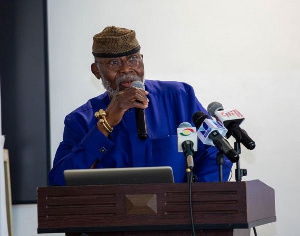Opinions of Saturday, 10 April 2004
Columnist: Boahene, Kwasi
Ghanaians refuse to re-enact the crucifixion of Jesus
As the majority of you might know, the people of Kwahu are noted for their observance of Easter. In fact, the celebration of Easter is rooted in the fabric of our social, religious and cultural systems. Before life began in the Garden of Eden, the Kwahus used to commemorate spring celebrations (Easter) to mark the exploits of Bruku (the God of Kwahu). There were other celebrations, beginning from the last Akwasidae of the year to the start of the farming season. For example, there was Eto Pitie at Obo, Akwasidae Kese at Bokuruwa and Abene and the celebrations of Okomfo YAW at Aduamoa.
With time, the Easter festivities at Kwahu attracted curious foreigners who were fascinated by the similarity in religious accolades of Kwahu and Christianity. For example, Okomfo YAW and the Jewish God, YAhWh shared the same name. Okomfo YAW also accepted limited animal sacrifice and had no shrine just as YAhWh in the Bible. Bruku came out of a Rock and Jesus was a Rock (1Cor 10:4). Bruku is called Kwasi, indicating the day in which he came to life; and the Christians also assert that Jesus was restored to life on Sunday.
Due to colonialism and its repressive practices, the authority of Bruku, other High Priests and Chiefs were undermined. The forced establishment of missionary headquarters at Kwahu Tafo (Roman Catholic) and Abetifi (Presbyterian) clashed with traditional cultures. At Twenedurase, Rev. Ramseyer, the founder of Presbyterian Church was regrettably shaved by inhabitants and made to carry ?aboma? (big drums) due to his disrespect for Kwahu culture and festivals.
Gradually, the original meaning and practices of the Kwahu spring celebrations began to erode. Now, the festival has assumed a social character as a period for family re-union and fundraising for community development. Easter is also meant for merry making, where cultural troupes and music bands such as Akonoba J.K.?s Band, T.O. Jazz, African Brothers, The Black Chinese (City Boys), Kojo Antwi and other youthful groups entertain the public.
One of the things, which the Christians have done at Kwahu Tafo and elsewhere is to re-enact the crucifixion of Jesus to counteract the procession of Chiefs and the High Priests in palanquin amidst drumming and chanting of holy hymns during the spring celebrations. In the past, Christians at Kawhu Tafo, Asakraka, Mpraeso, Bepong and Abetifi just to mention a few towns used to organise a procession led by a man acting as Jesus wearing a long red dress and carrying a heavy wooden cross to parade the streets. The procession was usually followed by male Church members dressed in look-alike uniforms of Roman soldiers with women at the rear who sang mourning hymns to remind us of the agony of Jesus in Gethsemane. In fact some women, either hired by the Church or out of their own free will followed the procession weeping bitterly.
At Kwahu Tafo, the whole crucifixion procession, which usually started around 10 am in the premises of the Church ended at the Catholic Primary School Park, where the man was condemned to death and fastened to a cross for about 5 minutes. In fact, the dramatisation of the crucifixion was an ingenious move by the Christians because it helped them attract attention and followers. For example, many days after the mock crucifixion, people, particularly the unemployed men and children would still be gathering under the big tree near the Post Office debating as to whether the man who acted as Jesus was really beaten or not and whether the paint or potassium permagnate (kansuo bre) poured onto his face was real blood.
There were specific men who always acted as the crucified Jesus. They were usually not members of the Christian community and were rumoured that they were paid by the Church to do so. At Kwahu Tafo and Asakraka, the task were performed by two particular men popularly known by inhabitants as Kofi Yesu. The Priests used to explain that re-enacting the crucifixion (i.e. conducting the procession of a crucified Jesus) was crucial for commemorating what Jesus did for mankind, atoning for our sins and seeking his intervention and blessings in our lives. However, one thing, which fascinated since I was a child was that none of the men who volunteered to be mocked and ?crucified? was rich. I never saw any wealthy, devoted Christian riding in Mercedes Benz, VW, BMW or even Tico come forward to re-enact the crucifixion of Jesus. Usually, the volunteers were poor men, who usually had difficulty in making ends meet and had the propensity to drink too much, including Ogogro.
Some time ago, a Dutch anthropologist who was overwhelmed by Kwahu festivals and practices decided to do research into the background of these men who have re-enacted the crucifixion of Jesus. What she found out was not inspiring. Life has not been very kind to these men in spite of their deep sense of voluntarism to help fellow Christians reflect and commemorate the death of Jesus. I have learned that in certain towns outside Kwahu such as Atwedie and Hia (Ashanti Region), Shama (Western Region), Assin Foso (Central Region), Adeiso, Nankese and Asene (Eastern Region), the fate of these Kofi Yesus has also not been gracious. Why is it that these men who have played the role of crucified Jesus are never prosperous or have never prospered economically and socially. Is it because the Hebrew Scriptures say, ?Anyone who is hung on a tree is under God?s curse?? (Deut. 21:23)
At Tafo, the church has decided not to use Kofi Yesu any more in their Easter dramatisation of the crucifixion of Jesus Christ because he was reprimanded harshly and openly by a kenkey seller for not honouring his debts. He has also been found several times drinking heavily at akpeteshie bar and could only reach home under the escort of some well wishers. The Church thought and rightly so that the behaviour of Kofi Yesu could not make Jesus proud. Since the Church ended its engagement with Kofi Yesu, it has been quite difficult for it to get a replacement because the young men in the town are not impressed about the social and economic status of former ?crucified? Jesus. My good old friend, Mr. AAA (Abraham Annan Adjei) of Shama, a devout Catholic also told me ?Kwasi, it is quite ironic that the men who volunteered to be mocked and ?crucified? during the Good Friday in Shama have not made it in life?. He continued, ?Nowadays it is difficult to get people to re-enact the crucifixion because they are afraid of the social and economic consequence?.
Consultant, Development Economics
Kwasi Boahene has been nominated as an expert member of the International Society for Religion and Socio-economic Development. He is also a co-founder of International Development Alternatives in Africa (IDEAS) Email: [email protected]










